2020 TOYOTA HILUX key
[x] Cancel search: keyPage 631 of 744
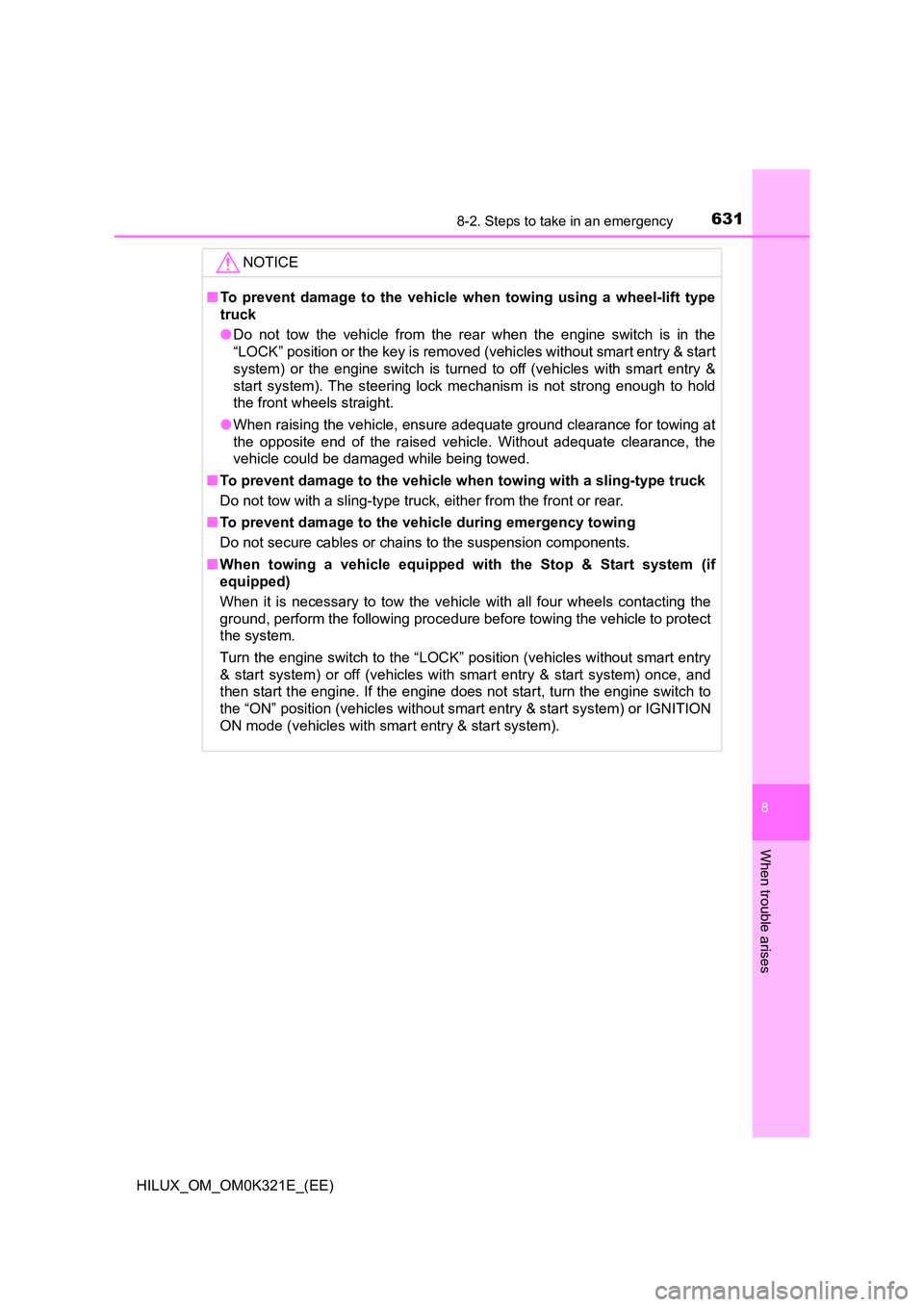
6318-2. Steps to take in an emergency
HILUX_OM_OM0K321E_(EE)
8
When trouble arises
NOTICE
■To prevent damage to the vehicle when towing using a wheel-lift type
truck
● Do not tow the vehicle from the rear when the engine switch is in the
“LOCK” position or the key is removed (vehicles without smart entry & start
system) or the engine switch is turned to off (vehicles with smart entry &
start system). The steering lock mechanism is not strong enough to hold
the front wheels straight.
● When raising the vehicle, ensure adequate ground clearance for towing at
the opposite end of the raised vehicle. Without adequate clearance, the
vehicle could be damaged while being towed.
■ To prevent damage to the vehicle when towing with a sling-type truck
Do not tow with a sling-type truck, either from the front or rear.
■ To prevent damage to the vehicle during emergency towing
Do not secure cables or chains to the suspension components.
■ When towing a vehicle equipped with the Stop & Start system (if
equipped)
When it is necessary to tow the vehicle with all four wheels contacting the
ground, perform the following procedure before towing the vehicle to protect
the system.
Turn the engine switch to the “LOCK” position (vehicles without smart entry
& start system) or off (vehicles with smart entry & start system) once, and
then start the engine. If the engine does not start, turn the engine switch to
the “ON” position (vehicles without smart entry & start system) or IGNITION
ON mode (vehicles with smart entry & start system).
Page 640 of 744
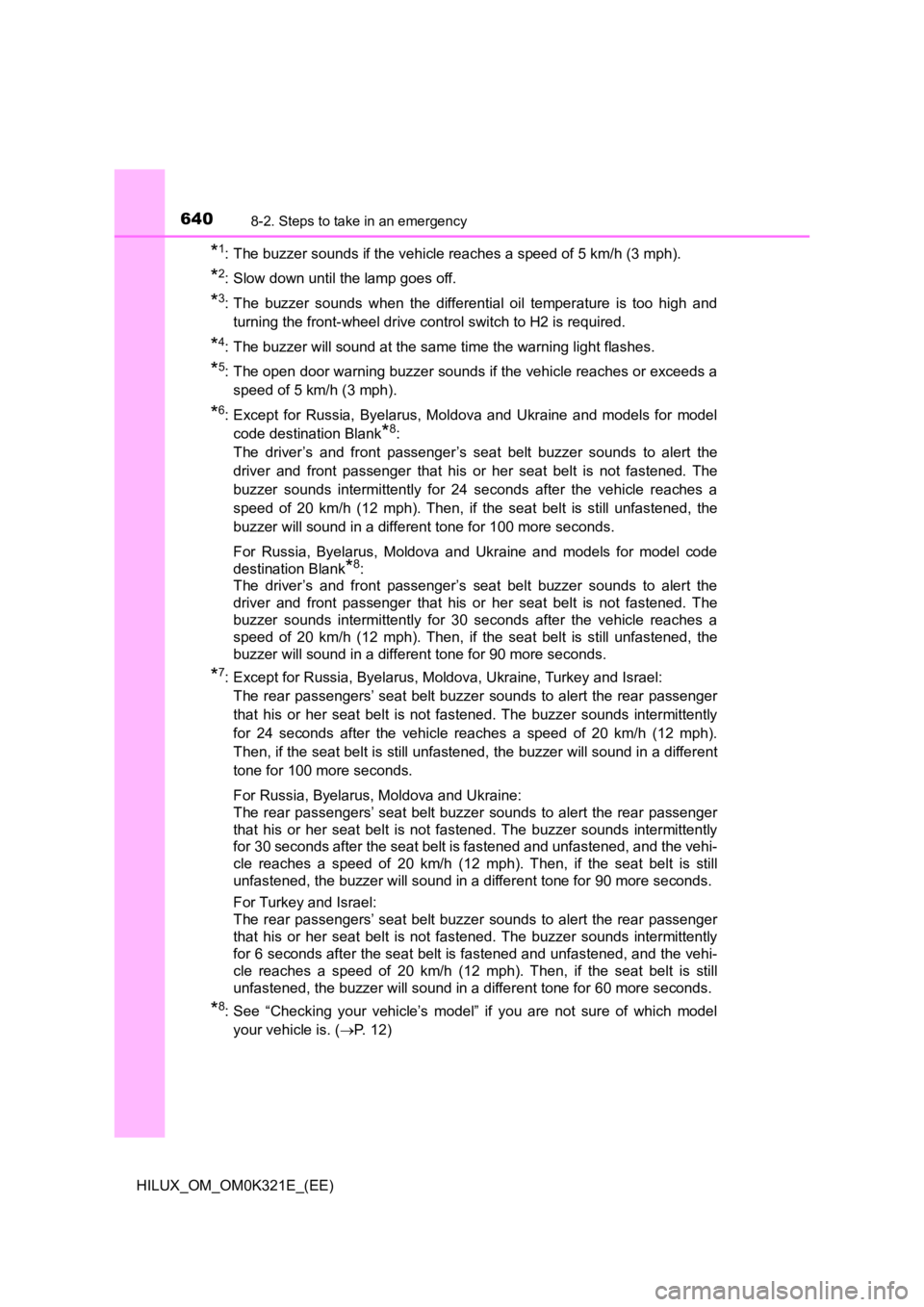
6408-2. Steps to take in an emergency
HILUX_OM_OM0K321E_(EE)
*1: The buzzer sounds if the vehicle reaches a speed of 5 km/h (3 mph).
*2: Slow down until the lamp goes off.
*3: The buzzer sounds when the differential oil temperature is too high and
turning the front-wheel drive control switch to H2 is required.
*4: The buzzer will sound at the same time the warning light flashes.
*5: The open door warning buzzer sounds if the vehicle reaches or exceeds a
speed of 5 km/h (3 mph).
*6: Except for Russia, Byelarus, Moldova and Ukraine and models for model
code destination Blank*8:
The driver’s and front passenger’s seat belt buzzer sounds to alert the
driver and front passenger that his or her seat belt is not fastened. The
buzzer sounds intermittently for 24 seconds after the vehicle reaches a
speed of 20 km/h (12 mph). Then, if the seat belt is still unfastened, the
buzzer will sound in a different tone for 100 more seconds.
For Russia, Byelarus, Moldova and Ukraine and models for model code
destination Blank*8:
The driver’s and front passenger’s seat belt buzzer sounds to alert the
driver and front passenger that his or her seat belt is not fastened. The
buzzer sounds intermittently for 30 seconds after the vehicle reaches a
speed of 20 km/h (12 mph). Then, if the seat belt is still unfastened, the
buzzer will sound in a different tone for 90 more seconds.
*7: Except for Russia, Byelarus, Moldova, Ukraine, Turkey and Israel:
The rear passengers’ seat belt buzze r sounds to alert the rear passenger
that his or her seat belt is not fastened. The buzzer sounds intermittently
for 24 seconds after the vehicle reaches a speed of 20 km/h (12 mph).
Then, if the seat belt is still unfastened, the buzzer will sound in a different
tone for 100 more seconds.
For Russia, Byelarus, Moldova and Ukraine:
The rear passengers’ seat belt buzze r sounds to alert the rear passenger
that his or her seat belt is not fastened. The buzzer sounds intermittently
for 30 seconds after the seat belt is fastened and unfastened, and the vehi-
cle reaches a speed of 20 km/h (12 mph). Then, if the seat belt is still
unfastened, the buzzer will sound in a different tone for 90 more seconds.
For Turkey and Israel:
The rear passengers’ seat belt buzze r sounds to alert the rear passenger
that his or her seat belt is not fastened. The buzzer sounds intermittently
for 6 seconds after the seat belt is fastened and unfastened, and the vehi-
cle reaches a speed of 20 km/h (12 mph). Then, if the seat belt is still
unfastened, the buzzer will sound in a different tone for 60 more seconds.
*8: See “Checking your vehicle’s model” if you are not sure of which model
your vehicle is. ( P. 1 2 )
Page 668 of 744
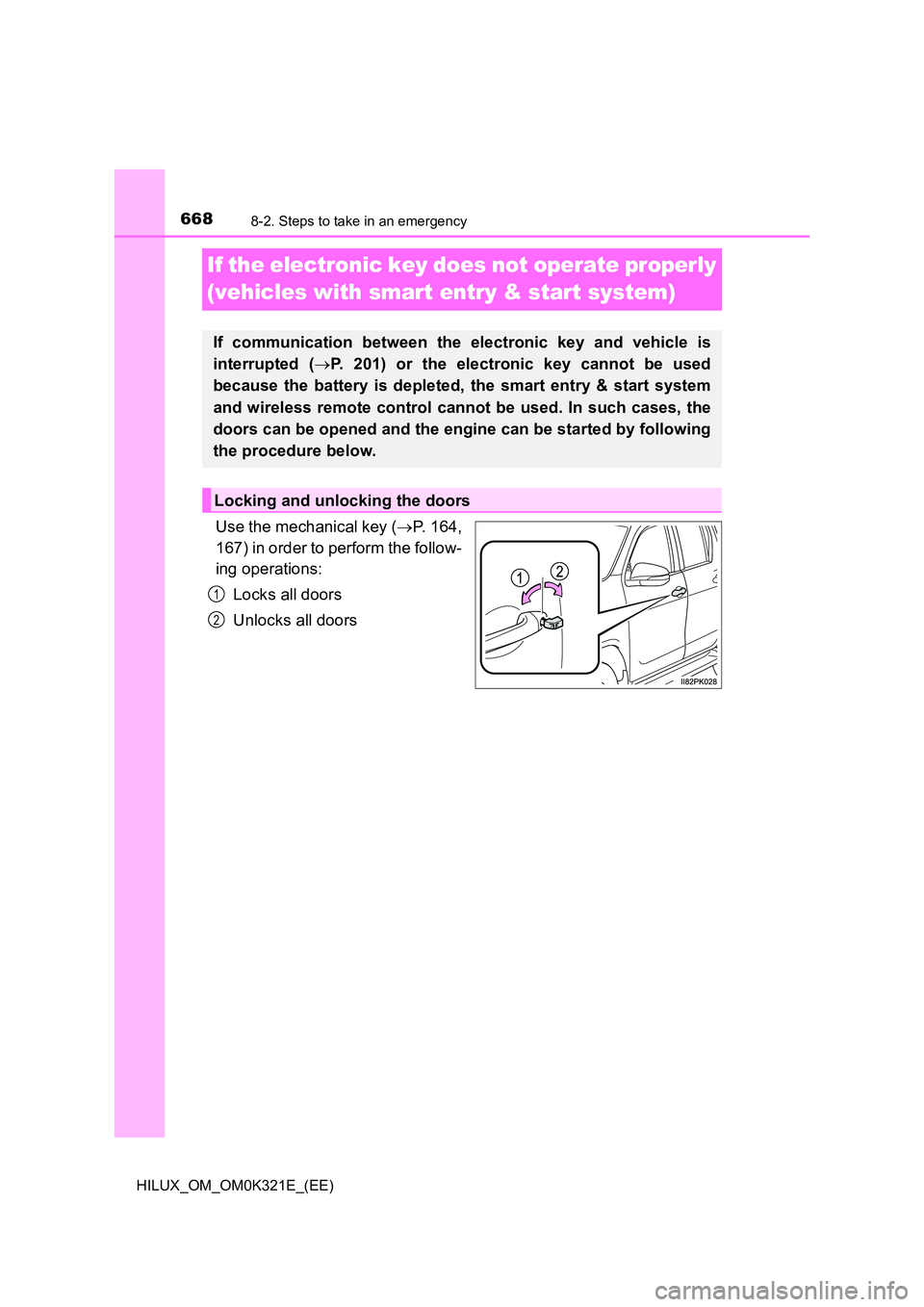
6688-2. Steps to take in an emergency
HILUX_OM_OM0K321E_(EE)
If the electronic key does not operate properly
(vehicles with smart entry & start system)
Use the mechanical key (P. 164,
167) in order to perform the follow-
ing operations:
Locks all doors
Unlocks all doors
If communication between the electronic key and vehicle is
interrupted ( P. 201) or the electronic key cannot be used
because the battery is depleted, the smart entry & start system
and wireless remote control cannot be used. In such cases, the
doors can be opened and the engine can be started by following
the procedure below.
Locking and unlocking the doors
1
2
Page 669 of 744

6698-2. Steps to take in an emergency
HILUX_OM_OM0K321E_(EE)
8
When trouble arises
Automatic transmission
Ensure that the shift lever is in P and depress the brake pedal.
Touch the area behind the lock
button and unlock button on the
electronic key to the engine
switch.
When the electronic key is
detected, a buzzer sounds and the
engine switch will turn to IGNITION
ON mode.
When the smart entry & start sys-
tem is deactivated in customization
setting, the engine switch will turn
to ACCESSORY mode.
Firmly depress the brake pedal.
A message indicating how to start the engine will be displayed on the
multi-information display.
Press the engine switch.
In the event that the engine still cannot be started, contact any autho-
rized Toyota retailer or Toyota authorized repairer, or any reliable
repairer.
Starting the engine
1
2
3
4
Page 670 of 744
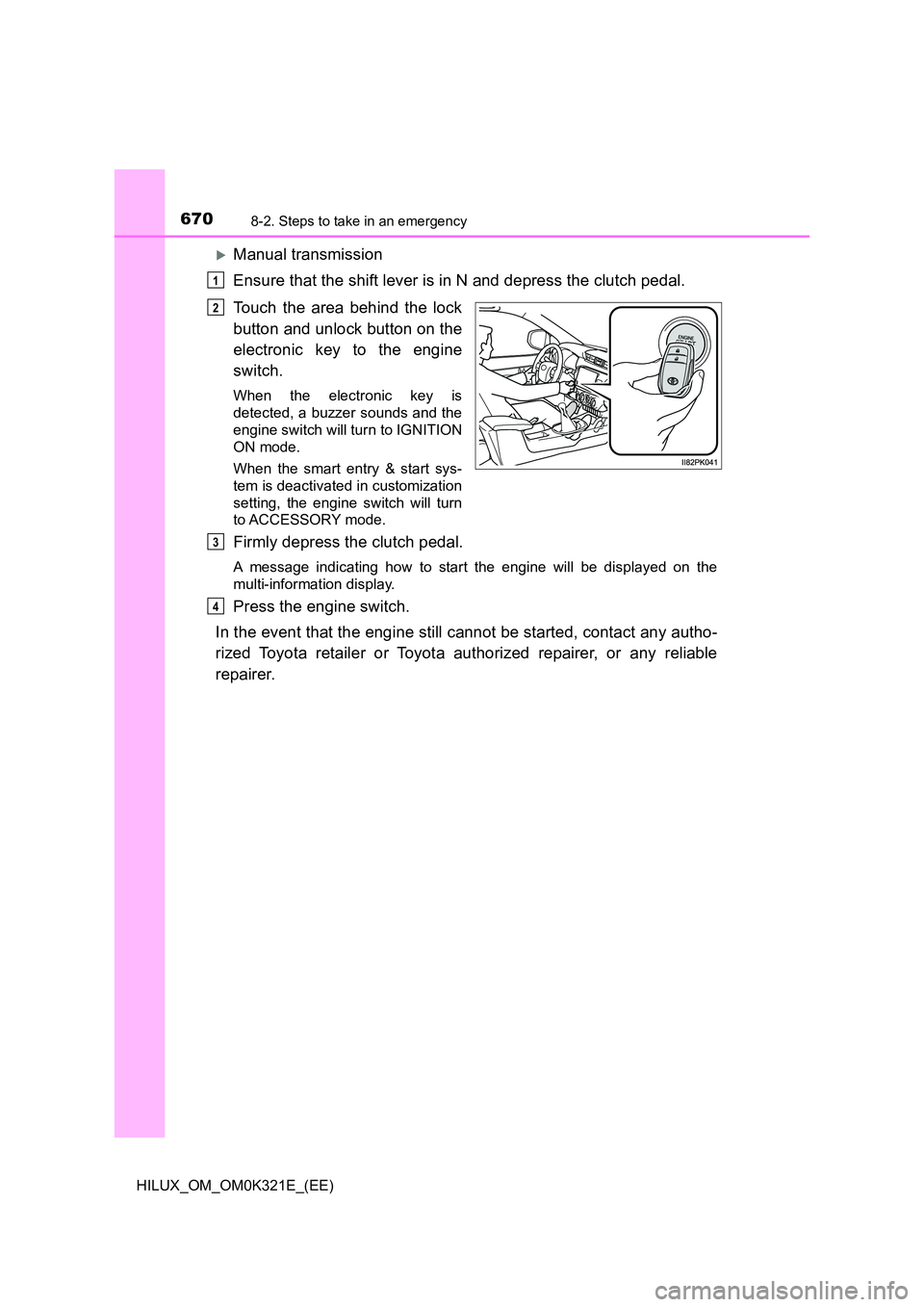
6708-2. Steps to take in an emergency
HILUX_OM_OM0K321E_(EE)
Manual transmission
Ensure that the shift lever is in N and depress the clutch pedal.
Touch the area behind the lock
button and unlock button on the
electronic key to the engine
switch.
When the electronic key is
detected, a buzzer sounds and the
engine switch will turn to IGNITION
ON mode.
When the smart entry & start sys-
tem is deactivated in customization
setting, the engine switch will turn
to ACCESSORY mode.
Firmly depress the clutch pedal.
A message indicating how to start the engine will be displayed on the
multi-information display.
Press the engine switch.
In the event that the engine still cannot be started, contact any autho-
rized Toyota retailer or Toyota authorized repairer, or any reliable
repairer.
1
2
3
4
Page 671 of 744

6718-2. Steps to take in an emergency
HILUX_OM_OM0K321E_(EE)
8
When trouble arises
■Stopping the engine
Shift the shift lever to P (automatic transmission) or N (manual transmission)
and press the engine switch as you normally do when stopping the engine.
■ Replacing the key battery
As the above procedure is a temporary measure, it is recommended that the
electronic key battery be replaced immediately when the battery is depleted.
( P. 599)
■ Alarm (vehicles with alarm for Kazakhstan, Armenia and Morocco)
Using the mechanical key to lock the doors will not set the alarm system.
If a door is unlocked using the mechanical key when the alarm system is set,
the alarm may be triggered.
■ Changing engine switch modes
Release the brake pedal (automatic transmission) or clutch pedal (manual
transmission) and press the engine switch in step above.
The engine does not start and modes will be changed each time the switch is
pressed. ( P. 288)
■ When the electronic key does not work properly
● Make sure that the smart entry & start system has not been deactivated in
the customization setting. If it is off, turn the function on.
(Customizable features: P. 718)
● Check if battery-saving mode is set. If it is set, cancel the function.
( P. 199)
3
Page 674 of 744

6748-2. Steps to take in an emergency
HILUX_OM_OM0K321E_(EE)
Once the vehicle’s engine has started, remove the jumper cables in
the exact reverse order from which they were connected.
Once the engine starts, have the vehicle inspected at any authorized
Toyota retailer or Toyota authorized repairer, or any reliable repairer
as soon as possible.
■ Starting the engine when the battery is discharged (vehicles with auto-
matic transmission)
The engine cannot be started by push-starting.
■ To prevent battery discharge
● Turn off the headlights and the audio system while the engine is off.
(Vehicles with Stop & Start system: Except when the engine is stopped due
to the Stop & Start system)
● Turn off any unnecessary electrical components when the vehicle is running
at a low speed for an extended period, such as in heavy traffic.
■ When the battery is removed or discharged
● Information stored in the ECU is cleared. When the battery is depleted, have
the vehicle inspected at any authorized Toyota retailer or Toyota authorized
repairer, or any reliable repairer.
● The power windows may not close normally. In this case, initialize the power
windows. (if equipped) ( P. 250)
■ Charging the battery
The electricity stored in the battery will discharge gradually even when the
vehicle is not in use, due to natural discharge and the draining effects of cer-
tain electrical appliances. If the vehicle is left for a long time, the battery may
discharge, and the engine may be unable to start. (The battery recharges
automatically during driving.)
■ When recharging or replacing the battery (vehicles with smart entry &
start system)
● In some cases, it may not be possible to unlock the doors using the smart
entry & start system when the battery is discharged. Use the wireless
remote control or the mechanical key to lock or unlock the doors.
● The engine may not start on the first attempt after the battery has recharged
but will start normally after the second attempt. This is not a malfunction.
● The engine switch mode is memorized by the vehicle. When the battery is
reconnected, the system will return to the mode it was in before the battery
was discharged. Before disconnecting the battery, turn the engine switch off.
If you are unsure what mode the engine switch was in before the battery dis-
charged, be especially careful when reconnecting the battery.
● Vehicles with Stop & Start system: After the battery terminals have been dis-
connected and reconnected or, the battery has been replaced, the Stop &
Start system may not automatically stop the engine for approximately 5 to
60 minutes.
6
Page 728 of 744
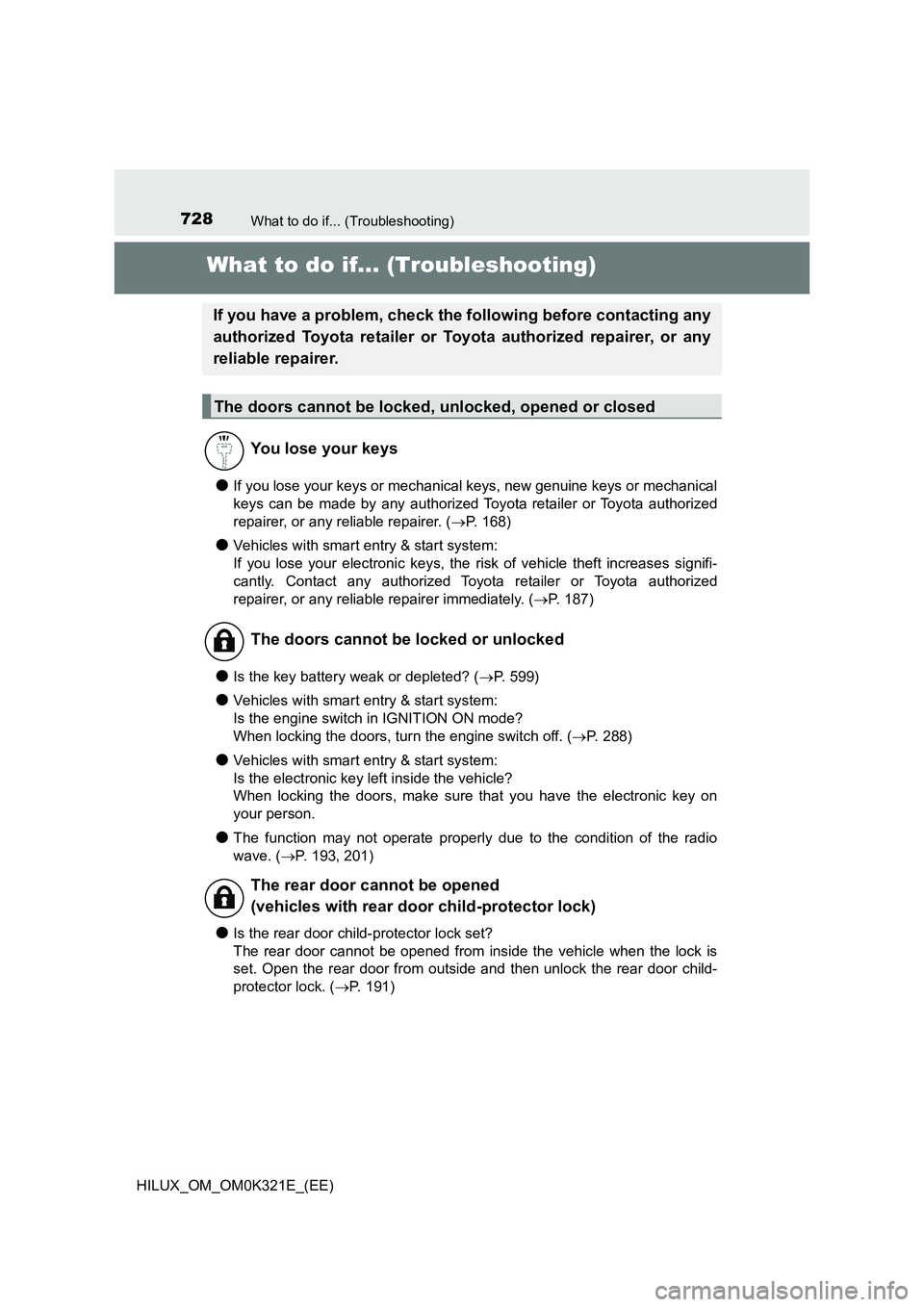
728What to do if... (Troubleshooting)
HILUX_OM_OM0K321E_(EE)
What to do if... (Troubleshooting)
●If you lose your keys or mechanical keys, new genuine keys or mechanical
keys can be made by any authorized Toyota retailer or Toyota authorized
repairer, or any reliable repairer. ( P. 168)
●Vehicles with smart entry & start system:
If you lose your electronic keys, the risk of vehicle theft increases signifi-
cantly. Contact any authorized Toyota retailer or Toyota authorized
repairer, or any reliable repairer immediately. ( P. 187)
●Is the key battery weak or depleted? (P. 599)
●Vehicles with smart entry & start system:
Is the engine switch in IGNITION ON mode?
When locking the doors, turn the engine switch off. ( P. 288)
●Vehicles with smart entry & start system:
Is the electronic key left inside the vehicle?
When locking the doors, make sure that you have the electronic key on
your person.
●The function may not operate properly due to the condition of the radio
wave. ( P. 193, 201)
●Is the rear door child-protector lock set?
The rear door cannot be opened from inside the vehicle when the lock is
set. Open the rear door from outside and then unlock the rear door child-
protector lock. ( P. 191)
If you have a problem, check the following before contacting any
authorized Toyota retailer or Toyota authorized repairer, or any
reliable repairer.
The doors cannot be locked, unlocked, opened or closed
You lose your keys
The doors cannot be locked or unlocked
The rear door cannot be opened
(vehicles with rear door child-protector lock)